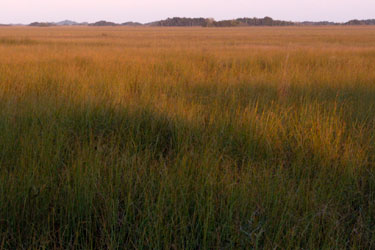
|

Sawgrass Prairie
The sawgrass prairie is the icon of the Florida Everglades and gives the region its name. This huge expanse of sawgrass once extended from
Sawgrass prairies form two different kinds of communities. The famous dense stands with grass standing well over a man’s head are a monoculture completely dominated by sawgrass (Cladium jamaicense). These communities have very low diversity and are unable to support large communities of fish and other wildlife. The more common sawgrass community consists of sawgrass that is more sparsely populated allowing other plants such as bladderwort and a number of sedge species to grow in between. This supports a large community of algae that forms a thick mat on the ground known as periphyton. This periphyton becomes the basis for the entire food chain. Small fish and invertebrates feed on the periphyton and provide food for larger fish which then support predators such as wading birds. One other characteristic of the sawgrass prairie, no matter how dense the vegetation, is the soil found below the plants. Under a sawgrass prairie, the soil is made up almost entirely of plant matter. This dead plant material is extremely slow to decay since it is submerged for the vast majority of the year. This organic soil, known as peat, can often be up to fifteen feet thick. This is a very fertile soil because of the large carbon source, however, the lack of other nutrients makes it difficult for other plants to colonize. Today we are losing large stands of sawgrass to the invasion of cattails. Sawgrass is extremely efficient at utilizing nutrients which allows it to out compete plants in an environment that is oligotrophic, or extremely low in nutrients. However, with the input of phosphorous and other nutrients from agricultural runoff and urbanization, cattails are able to replace the sawgrass. These cattails become extremely dense monocultures that do not support the periphyton community and therefore the rest of the aquatic food chain is absent. |
